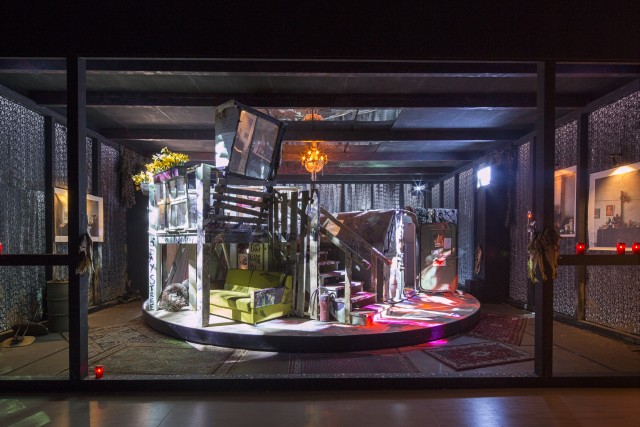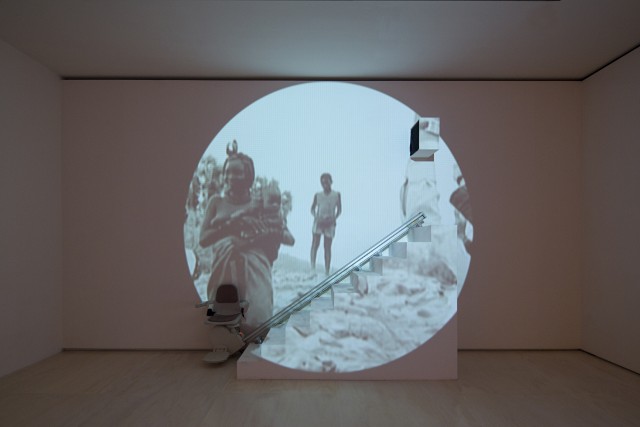
Christoph Schlingensief’s “The Animatograph” offers a unique, unpredictable journey at MoMA PS1 (© 2014 MoMA PS1; photo by Matthew Septimus)
MoMA PS1
22-25 Jackson Ave. at 46th Ave.
Thursday – Monday through September 1, suggested admission $10
718-784-2084
www.momaps1.org
www.schlingensief.com
Staging a retrospective of a late performance artist whose work was very much of the moment can be a daunting, difficult task, but curators Klaus Biesenbach, Anna-Catharina Gebbers, and Susanne Pfeffer have done a terrific job with the simply titled “Christoph Schlingensief,” MoMA PS1’s exciting exploration of the career of the German multidisciplinary artist who died in 2010 at the age of forty-nine. Over the course of thirty years, Schlingensief produced experimental films, cutting-edge operas, radical theater pieces, and public actions and interventions that shattered the boundaries between audience and performer and challenged the social and political status quo of his native country and beyond. The expansive exhibition examines Schlingensief’s working process and the reaction to his pieces through film and video clips, photographs, documentation, installation, related paraphernalia, and lots of wall text that puts his oeuvre in context. For “Chance 2000,” Schlingensief formed a political party that fought for the rights of the marginalized; for one event, Schlingensief called for people to bathe in a lake at Chancellor Helmut Kohl’s summer home, hoping to get enough participants to flood the house. In “Please Love Austria — First Austrian Coalition Week,” Schlingensief mocked right-wing anti-immigration zealots by placing twelve supposed asylum seekers in containers and filming them Big Brother-style. For Parsifal, Schlingensief reimagined Richard Wagner’s opera at the Bayreuth Festival, incorporating contemporary religious symbolism and a decomposing rabbit.

Visitors are sure to get a rise out of Christoph Schlingensief’s intimate and personal “Stairlift to Heaven” (© 2014 MoMA PS1; photo by Matthew Septimus)
The audience became protesters in Rocky Dutschke ’68, following Schlingensief into the street as he re-created a famous shooting while declaring, “No Power for Anyone.” MoMA PS1 visitors can get involved themselves in several interactive installations. You can take a seat in a comfy living-room set to watch Schlingensief’s unique television show Talk 2000, which challenged the conventions of the genre. You most definitely should walk all around “The Animatograph,” a rotating multimedia house of bizarre horrors with surprises at every turn. And in “Stairlift to Heaven,” individuals strap themselves into a chairlift that takes them up past a projection of excerpts from Schlingensief’s 2007 film, The African Twin Towers, and to a private viewing booth. Schlingensief’s legacy continues with “Opera Village Africa,” an “artistic reservoir for the future” that is an actual village he and his wife, Aino Laberenz, built in Burkina Faso, complete with a hospital, a primary school, a theater group, a birthing clinic, and more, overseen by Laberenz since her husband’s death from lung cancer in 2010. “What kind of art is it that no longer has any access, no longer lets anyone in, and also doesn’t step out of itself?” Schlingensief asked. “Here the idea is to finance an art platform which is to serve as a basis for children and teenagers. So we can learn again how creativity comes about and develops. That’s the idea of the Opera Village.” It’s also the central focus of most of his work, the intersection of art and activism, producing public actions and interventions — with a wicked sense of humor and an anarchic distaste of authority — that can impact complacency and conventionality potentially on a global scale, even after his death. “Nothing is certain because I show it. Everything describes itself, overwrites and dissolves,” he once said. “This is not fatalism; this is my principle of pleasure.” There is much pleasure to be found in this dazzling display, especially for those who invest the time to soak in all the thrilling details.